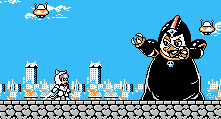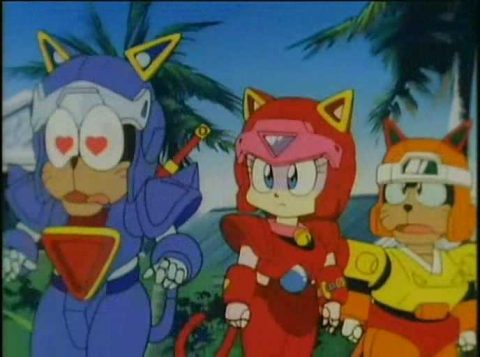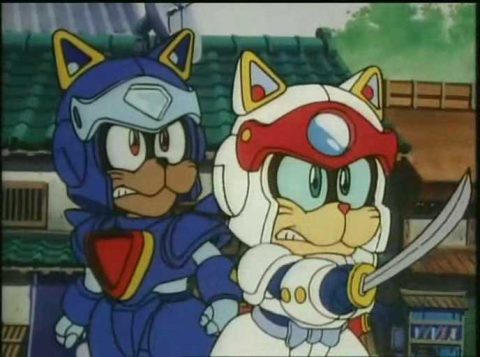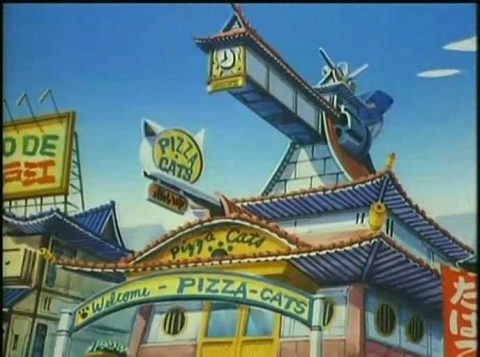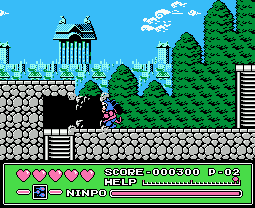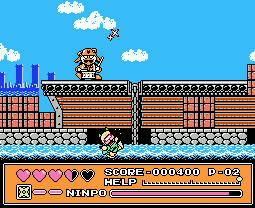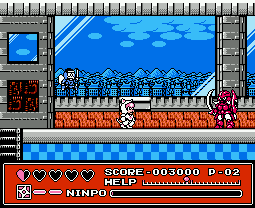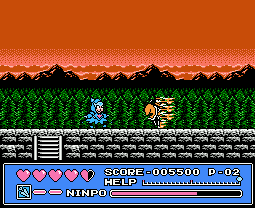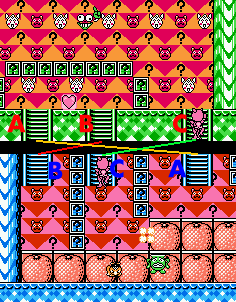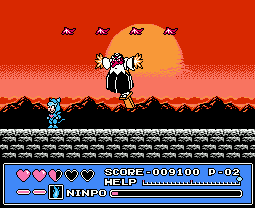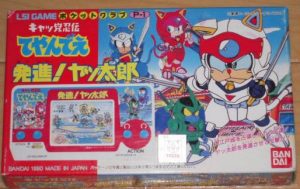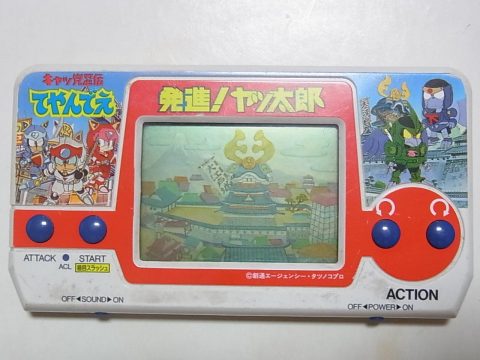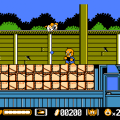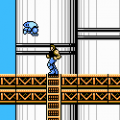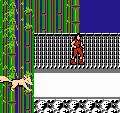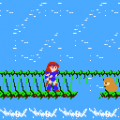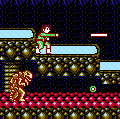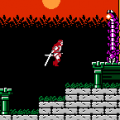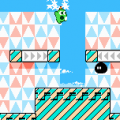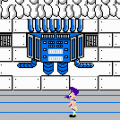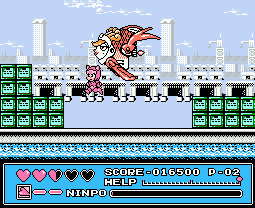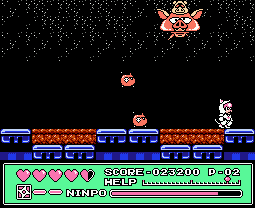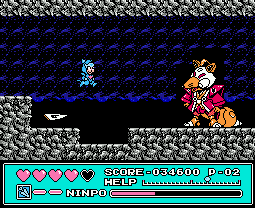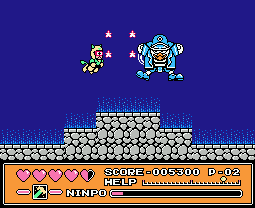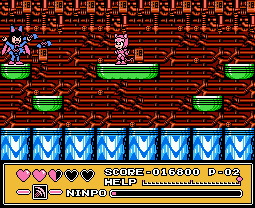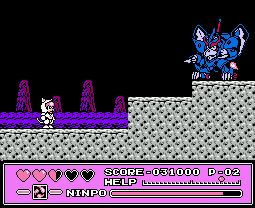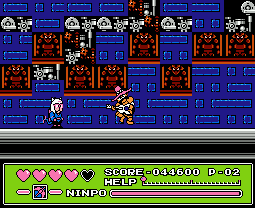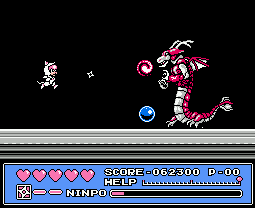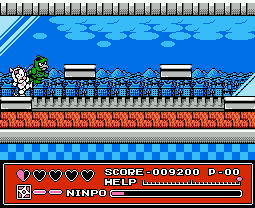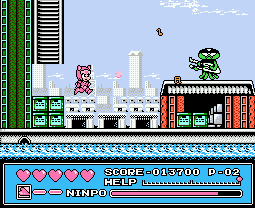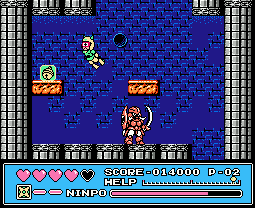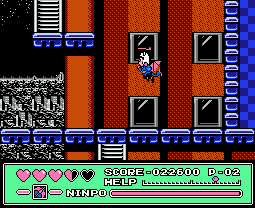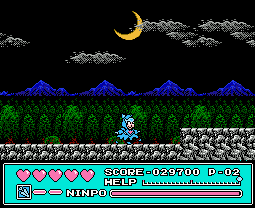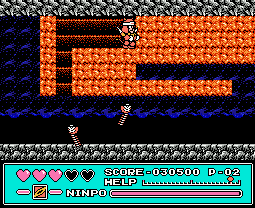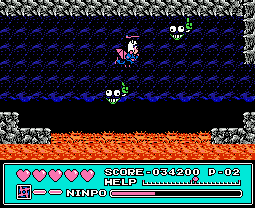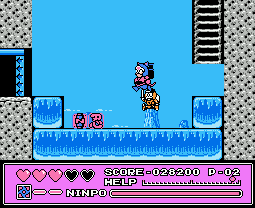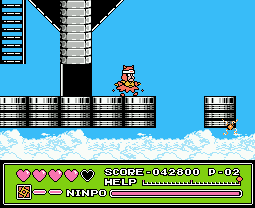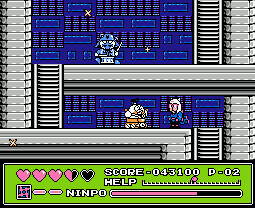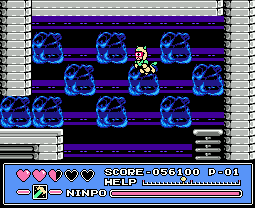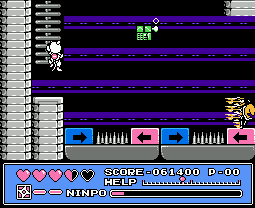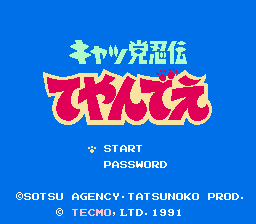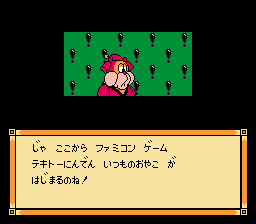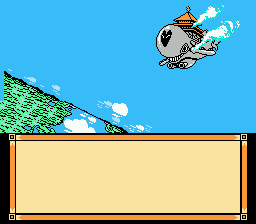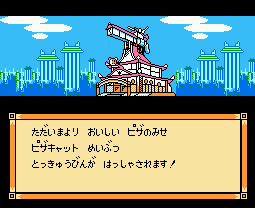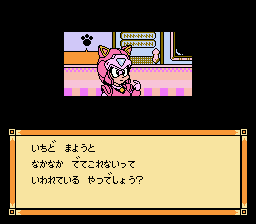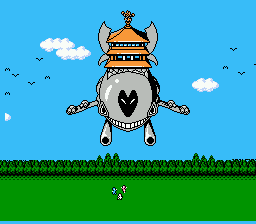The 1980s and early 1990s were a great time to be a kid watching television. There was an abundance of cartoon series featuring bizarre, mutated or otherwise anthropomorphic superheroes and outcasts, taking place in all manner of outlandish settings. Probably the biggest was Teenage Mutant Ninja Turtles, which spawned a dizzying array of related games, not to mention copycats. Anthropomorphic and/or mutant heroes were the in thing, long before words like “furry” conspired to ruin otherwise innocent childhood memories. There was Thundercats, Swat Kats, Bucky O’Hare, Biker Mice From Mars, and the Troma-inspired Toxic Crusaders – to name but a few – all of which also had tie-in games of varying quality.
Amidst this maelstrom of mutagen fueled cartoon adventure, one of the better TV series was Kyattou Ninden Teyandee (キャッ党 忍伝 てやんでえ) from 1990-1991. Also known as Samurai Pizza Cats in the west, it was the creation of Tatsunoko Productions and Sotsu Agency in Japan. It ran for about a year and was localized by Saban for English speaking countries. The original Japanese name is unusual, because rather than use the word neko (Japanese for cat), they used the English word cat spelled in katakana, which would have lent the name an exotic echo to the Japanese ear. The oddness doesn’t end there though, since the final “tou” syllable in the word cat is a kanji symbol, meaning something like club, party, or association. So there’s a whole sub-level of subtlety going on in the name.
It was a great series for several reasons. For young kids it was was packed with madcap shenanigans and action, as the three Samurai cats, who also worked in a pizza restaurant, fought crime in the city of Little Tokyo. If there were any moral messages in the show’s stories they weren’t obvious, or certainly they weren’t put across in a ham-fisted way like most other shows. No, instead children were treated to/subjected to an insane jive talking panda who had fathered a bunny rabbit, a super-camp transvestite fox/rat called Seymour Cheese (see more cheese, geddit?), and stories involving the two male crime-fighting cats in love with a female sheep which had the horns of a male ram. If these inter-species gender-bending discrepancies didn’t warp the minds of an entire generation, then the fact the ram/sheep shot missiles out of her mechanical skull when upset probably did. The whole thing was like a kung-fu hotdog wrapped in a warm blanket of insanity.
For any adults watching alongside their offspring, there was also just enough “adult” references to make it equally enjoyable. The reason behind this is especially interesting. According to unsourced explanations online, when Saban was localizing the show they were given the Japanese tapes, but not transcripts of the dialogue to translate. As a result, Saban producer Andy Thomas had fresh scripts written, essentially ad-libbing the entire show. Which perhaps makes it analogous to Takeshi’s Castle. Dialogue broadly matched the visual story, but it was clear the guys at Saban were having some fun when remaking it. So there are episodes with political jokes which throw around the words pinko and fascist, various mild innuendos, plus all manner of fourth wall breaking and absurd surrealism, just to fill the animated lip-flap of onscreen characters. Given the risqué nature of some jokes, of the 52 episodes localized 12 of them ended up being unreleased in America. Knowing how the dialogue came to be recorded, rewatching the series today shows it to have aged slightly better than most children’s programs. (Discotek Media brought out a complete boxset for the series.)
In addition to various merchandising tat, mainly released in Japan, there were two videogames released. Sort of. Licensed games are not known for their universal quality; some are great, but many are downright terrible.
Additionally, on the Famicom and NES the platformer became the ubiquitous genre-de-jour, with the market saturated. Therefore it’s a pleasant surprise to discover that Samurai Pizza Cats is an excellent licensed platformer, one of the best on the system in fact. Developed by Tecmo, of Ninja Gaiden fame, it compares favorably to any that Konami or other cartoon licensees released around that time. Given this, and the fact the cartoon it was based on actually reached the west, the lack of western localisation is a great shame. Though fans of Famicom bootlegs and those living in Eastern Europe may have come across an unofficial Russian hack – complete with Cyrillic text.
Taking place over 11 stages, at the start of each you can choose between one of the three main cats: Speedy, Guido or Polly. Apart from suit colours there’s almost no difference between, making choosing fairly redundant. In addition to standard attacks each character has a projectile attack by pushing Up and B, a bit like Ninja Gaiden. This can be powered up between three strength levels by collecting the little kanji items, and the stronger the attack the more it depletes your Ninpo meter. You start with throwing stars, next a three way attack, and then basically a power bomb. Ninpo can be topped up by collecting the scroll power-ups, while health is replenished through hearts. Re-entering a room causes all power-ups to reappear, so you’re never short. Each stage also has its own boss enemy.
So far, so prosaic. Superficially it seems no different to a hundred other NES platformers. What elevates it is the level design and inclusion of four extra characters, based on the cartoon series’ Rescue Team. Any one of the four can be selected at any time through the pause menu, and can be kept for the duration of a level if preferred. What makes them special is that each has a unique power, either smashing obstacles, digging through soil, swimming underwater or flying. Use of these powers eats into a special “HELP” bar, but switching back to the default character allows this to recharge. It’s actually really clever – the starting character you choose isn’t about picking the best one for the current job, it’s about picking your favorite from the show. Tactics then come into play when using the secondary characters who, just like in the TV series, are much more competent at getting things done than the main three.
Plenty of other games allow selection between characters with differing abilities, but here it’s especially well done. With something like the first TMNT there wasn’t much difference apart from attack range, certainly none of the turtles could fly. In Bucky O’Hare you first had to rescue a character before using them. In Tiny Toons you basically chose between Buster, who was useless, or one of three others, who couldn’t be cycled between once in a level. The system in Samurai Pizza Cats is much more generous, well balanced with regards to recharging, and actually gives you a reason to switch between them. It’s almost like a less restrictive version of Mega Man’s powers.
But it’s not just the mechanics that would have made this a great game to play back in 1991. It did a good job of also capturing the visual spirit of the TV series (languages/dialogue differences aside), with many characters from the cartoon turning up in cut-scenes. Throughout, the visuals are excellent for a Famicom title – to find better you’d need to look at the best from Konami or Nintendo from this era. Everything is well animated and makes good use of available colours, with a lot of diversity to the locations, even if several enemies are palette swaps. A few stages also have parallax scrolling in the backgrounds, which isn’t too common on the Famicom. Plus it’s full of wacky characters, like a guitar playing octopus! How can you not love that?
Characters
Speedy Cerviche (Yattarou)
Leader of the crime-fighting trio, he controls similarly to the other two though attacks with a medium-range sword. Has a crush on Lucille in the cartoons.
Guido Anchovy (Sukashii)
A smooth talking cool cat in blue, who wields an umbrella as a weapon, with an imperceptibly longer range. Also has a crush on Lucille in the cartoon.
Polly Esther (Pururun)
The girl of the group, she wears pink and attacks with her claws, giving her a slightly shorter range of the three.
General Catton (Rikinoshin)
Leader of the four-cat Rescue Team that supports the main trio. He has the strength to smash concrete blocks with his paws. Doesn’t see much use.
Bat Cat (Mietoru)
Probably the most useful of the Rescue Team, he can fly at will anywhere in the game, except underwater. Good for bypassing enemies and traps, and reaching inaccessible areas.
Meowzma O’ Tool (Gotton)
Sporting a drill to dig through sections of orange soil, he’s the least useful in the Rescue Team. While most such areas contain a power-up, they can also often be skipped entirely.
Spritz T. Cat (Nekkii)
Decked in scuba gear this cat is essential for underwater sections. Regular characters hop about underwater, but he glides easily. Don’t be afraid of watery pitfalls – jump right in!
Francine (Otama)
In the cartoon she’s in charge of the pizza restaurant and fires the cannon which launches the Pizza Cats. In-game she pops up in cutscenes to further the story.
Lucille (Omitsu)
The focus of Speedy and Guido’s attention, this female sheep bizarrely has the larger curved horns of a male ram and, in the cartoon, launches missiles from her skull when upset.
Big Al Dente (Inuyama Wanko-no-Kami)
The chief dog in charge of the Samurai Pizza Cats, he assigns missions in the cartoon, and takes part in several in-game cut-scenes.
Lady Vi (Usa Hime)
The rabbit daughter of the mad Emperor Panda in the cartoon. She accepts passwords when continuing in-game.
Mother Mutt and Junior (Itsumono Oya and Itsumono Ko)
These two often appear in the cartoon, and are present in several in-game cut-scenes, including a clever 4th wall breaking one where the mom makes reference to the Famicom game.
Seymour Cheese (Kitsunezuka Ko’on-no-Kami)
A mechanised fox (rat in the localisation) who is both Prime Minister of Little Tokyo and the head of the bad guys. Hobbies include cross-dressing and exploding. Takes the role of a boss enemy.
Jerry Atric (Karasu Gennarisai)
Second in command after Seymour Cheese, he pops up in cut-scenes and has to endure the wrath of his exploding boss.
Bad Bird (Karamaru)
Head of the grunts, he pops up repeatedly when enacting the nefarious plans of Seymour. He is also the ultimate boss for the game, though isn’t too tough.
In addition to well implemented extra characters, there is some really clever structuring. Most of the levels have branching pathways to the boss, providing light exploration and good reason to replay the game. There’s also a total lack of bottomless pitfalls; even on the later sky stage, if you fall off the edge you just fall down to the starting screen. Things like lava and spikes will damage you, but what seems like a deadly hole will just take you onto a branching pathway (such as under the water in early stages), or to an earlier part of the level. Some stages get pretty creative with folding space in on themselves, for some physics-defying layouts. Levels are quite compact though, so it never gets frustrating – in fact it’s fun to discover that having taken the left-hand path, you can eventually double back to the start of the right-hand branch.
After the first, stages 2-4 can be completed in any order, and after this stages 5-7 can again be done in any order. The final four stages are sequential. This is a brilliant system which again helps to reduce repetition during replays and, in the highly unlikely event that someone finds a level too tough, they can play around in the others until they’re more skilled.
Of course, no one who plays Samurai Pizza Cats will ever get stuck, and this is where negatives should be noted. It was obviously designed for young school children. As such no veteran player of any competence is likely to have trouble, or even lose a life, until the last couple of stages. In fairness the last two stages are pretty tricky, but this is more to do with cheap enemy placement. (One interesting and speculative point, regarding its target audience, is the fact that apart from the title screen, there’s no kanji script. It’s all in hiragana and katakana scripts. Of course this could equally be a result of the hardware’s difficulty in rendering more complex characters.)
The later levels do shine though, with some especially wacky spatial bending and clever ideas. One room has no floor, and is instead filled with floating cubes of gelatinous water. Failure to navigate it correctly results in falling down to an earlier screen, thereby requiring good use of Spritz to basically fly through the air thanks to these floating cubes. The funhouse level is also great, with warp rooms and branching pathways to trap the unsuspecting. Moments like these in Samurai Pizza Cats imply a greater sense of ability than the development team were harnessing. It’s not that the early levels are bad, quite the contrary, but there’s a strong sense of holding back in case they upset younger players. The fact that there’s a password system and infinite continues just reinforces this. Perhaps if it had been officially localized for the US market the difficulty would have been ramped up to compensate – as it stands, it’s one of the easiest games on the system.
Most people who try it today will probably complete it in an afternoon and dismiss it as easy fodder. But stop to consider the layouts and some of the ideas, or how well the character selection is integrated, and there’s a pleasant sense of depth to the overall experience – just one that wasn’t pushed as hard as it could or should have been. A localisation that increased the difficulty, or a beefed up sequel, could have yielded a much discussed classic. Otherwise, it’s just a really super fun platformer.
The only other spin-off game appears to be this extremely obscure LCD handheld from Bandai, who seemed to churn out trillions of such licensed devices over the years. There’s very little information online – in fact the only website resource we found was the FREE MODE blog, where the photos of the unit itself came from. They describe it as difficult and repetitive. It seems to follow the basic gameplay of all such LCD handhelds, with two movement buttons (clock and anti-clockwise), plus an attack button.
